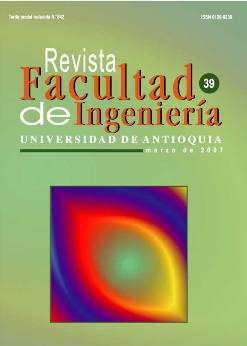Síntesis y caracterización de elastómeros de poliuretano a partir de poliol-suspensiones de aceite de higuerilla y almidón de yuca
DOI:
https://doi.org/10.17533/udea.redin.20236Palabras clave:
aceite de higuerilla, almidón de yuca, transesterificación, poliuretanosResumen
En este trabajo se llevó a cabo una doble modificación del aceite de higuerilla mediante transesterificación con pentaeritritol y posterior incorporación de almidón de yuca, obteniéndose los denominados poliol-suspensiones, los cuales se caracterizaron mediante:índice de hidroxilo, viscosidad y gravedad específica. A partir de los poliol-suspensiones se sintetizaron elastómeros de poliuretano, utilizando MDI como diisocianato. Estos materiales se caracterizaron mediante resistencia a la tensión, dureza y ataque químico. Se utilizaron diferentes cantidades de pentaeritritol y tres especies de almidón en la doble modificación del aceite con el fin de aumentar la funcionalidad hidroxílica y el porcentaje de amilopectina. Además, se varió la relación de grupos funcionales reactivos NCO/OH en la síntesis de los materiales. Se encontró que la adición de un 5% de almidón a los polioles generó incrementos del índice de hidroxilo en los poliol-suspensiones y una mejora de las propiedades físicomecánicas en los materiales sintetizados al compararlos con los sintetizados por vías independientes de modificación del aceite, obteniéndose una amplia gama de materiales.
Descargas
Citas
S. Desai, I. Thakore, B. Sarawade, S. Devi. “Structure-Property relationship in polyurethane elastomers con-taining starch as a crosslinker”. Polymer Engineering & Science. Vol. 40. 2004. pp. 1200-1210. DOI: https://doi.org/10.1002/pen.11247
H. Seung-Kyu, H. Broecker. “The crosslinking of polyurethane incorporated with starch granules and the rheological properties: influences of starch content and reaction conditions”. Macromolecular Materials & Engineering. Vol. 288. 2003. pp. 569-577. DOI: https://doi.org/10.1002/mame.200350005
M. Valero, M. Martínez, H. Ramírez, M. Valdivieso, D. Duarte, A. Ramírez, J. Pulido. “Preparación y comportamiento de polímeros de redes simultáneamente interpenetradas (SIN), formadas por poliuretano de aceite de higuerilla modificado y poliestireno”. Memorias del Congreso Colombiano de Ingeniería Química. Manizales (Colombia). 2005.
M. Duarte, J. Socarrás, J. Pulido, A. Ramírez. Síntesis y caracterización de elastómeros de poliuretano a partir de metilen difenil diisocianato (MDI) y aceite de higuerilla modificado con almidón de yuca. Tesis de pregrado en Ingeniería Química de la Universidad Industrial de Santander. Bucaramanga (Colombia). 2005. pp. 20-30.
J. Cabrera, K. Navas, J. Pulido, A. Ramírez. Síntesis y caracterización de elastómeros de poliuretano y redes interpenetradas (IPN) a partir de poliol-suspensiones de aceite de higuerilla y almidón de yuca, y estireno. Tesis de pregrado en Ingeniería Química de la Universidad Industrial de Santander. Bucaramanga (Colombia). 2005. pp. 20-30.
J. Siddaramaiah, B. Kendaganna. “Structure property relationship of the starch-filled chain-extended polyu-rethane”. Journal of Applied Polymer Science. Vol. 90. 2003. pp. 2945-2954. DOI: https://doi.org/10.1002/app.12920
Descargas
Publicado
Cómo citar
Número
Sección
Licencia
Los artículos disponibles en la Revista Facultad de Ingeniería, Universidad de Antioquia están bajo la licencia Creative Commons Attribution BY-NC-SA 4.0.
Eres libre de:
Compartir — copiar y redistribuir el material en cualquier medio o formato
Adaptar : remezclar, transformar y construir sobre el material.
Bajo los siguientes términos:
Reconocimiento : debe otorgar el crédito correspondiente , proporcionar un enlace a la licencia e indicar si se realizaron cambios . Puede hacerlo de cualquier manera razonable, pero no de ninguna manera que sugiera que el licenciante lo respalda a usted o su uso.
No comercial : no puede utilizar el material con fines comerciales .
Compartir igual : si remezcla, transforma o construye a partir del material, debe distribuir sus contribuciones bajo la misma licencia que el original.
El material publicado por la revista puede ser distribuido, copiado y exhibido por terceros si se dan los respectivos créditos a la revista, sin ningún costo. No se puede obtener ningún beneficio comercial y las obras derivadas tienen que estar bajo los mismos términos de licencia que el trabajo original.










 Twitter
Twitter